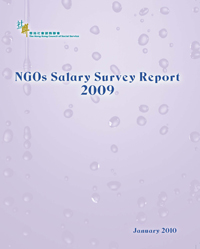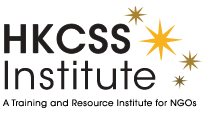NGOs Salary Survey 2009

Introduction
The introduction of Lump Sum Grant has transformed the resources management of the Non-governmental Organizations (NGOs), especially in human resources management. NGOs are given the freedom to manage their staff structure, staff-mix and the level of compensation and benefits under the new funding mode.
NGOs of the welfare sector are entering into the post-Tide-Over Grant (TOG) period. With regard to the expenditure in salary and benefits, it usually carries over 70% of the total expenditure of an organization. To facilitate NGOs in determining the levels of salary and benefits with flexibility to meet their organizational requirements, NGOs need more information from the comparable sectors to set a fair and reasonable remuneration and benefits system for their own organizations.
The Hong Kong Council of Social Service (the “HKCSS”) commissioned Hong Kong Institute of Human Resource Management Ltd. (the “HKIHRM”) to conduct the HKCSS Salary Survey 2009 (the “Survey”) among the Agency Members of HKCSS. The Report intends to provide participating Agency members more comprehensive and updated sector-wide information on the salary and benefits offered by the members to their staff.
In the Survey of the past 5 years, the pay data did not cover “snapshot” staff of participating agencies receiving subvention from the Social Welfare Department of HKSAR Government. This year, due to the completion of TOG, more organizations will review their salary scales. Therefore the pay data covered has expanded to those NOT strictly following the Master Pay Scale (MPS). The Survey this year includes the new items “average percentage of overall salary adjustment awarded”
The results of the Survey aim to provide reference information to assist the participating agencies in positioning their remuneration and benefits strategies to attract, reward and motivate employees and revamping the relevant practices to meet the challenging operating environment.
- 3 year (2006 – 2008) salary trend comparison; and
- analysis of turnover rate.
The results of the Survey aim to provide reference information to assist the participating agencies in positioning their remuneration and benefits strategies to attract, reward and motivate employees and revamping the relevant practices to meet with the challenging operating environment encountered by the NGOs.
Objective and Scope
The objective of this Survey is to provide reference information for the participating agencies on a most recent:
- Summary of salary data for a set of benchmarked positions in different job families;
- Report of benefits offered to different levels of staff by NGOs;
- Analysis of HR practices among NGOs;
- Comparison of past years salary level trends for each of the job title included in the study of whose salary scale does not strictly follow the MPS;
- Average percentage of overall salary adjustment awarded to eligible staff in organizations as a result of the regular salary review
The scope of this Survey covers the latest remuneration practices of the selected benchmarking jobs, benefits offered to different levels of staff and other human resources management of the participating agencies at the reference date as at 31 October 2009. This year, the data of the Survey covered full-time staff in-post whose salary scale does not strictly follow the Master Pay Scale (the “MPS”). A total of 36 benchmarked jobs have been selected for this Survey in light of their specific nature to the social service sector and market pay data is not readily available.
The Survey attempts to provide a comprehensive analysis of the human resources management practices of the NGOs in the social service sector. We hope the Survey will pave the ground work for NGOs to further develop and better utilize their most valuable assets - Human Resources.
Survey Methodology
The following methodology was deployed in this Survey.
Design of the Survey
With the input of the Task Group from HKCSS, the questionnaire and job descriptions for benchmarked jobs were developed. The objectives of the design are to:
- ensure adequate representation and fair interpretation of findings
- collect empirical data and views from participating agencies on their current practices in salary and benefits; and
- spot differences in remuneration practices due to the heterogeneity of agencies.
To facilitate the participating agencies to complete the questionnaire, an Explanatory Note with step-by-step instructions was developed. HKCSS representatives served as hotline support for agencies enquiries.
Data Collection and Response Rate
All Agency Members (364 agencies) of The Hong Kong Council of Social Service were invited to participate in this Survey. A total of 73 Agency Members returned the completed questionnaires to HKIHRM directly. With reference to the statistics on Social Service Organizations, which was published in the Directory of Social Service Organizations in Hong Kong 2009, the number of full time staff covered in this Survey, 25,935 was accounting for 53% of those in the social service sector.
Data Analysis and Report
Data were entered as electronic file for tabulation and analysis by HKIHRM in a professional and strict confidential manner. Necessary clarifications were made by HKIHRM to resolve potential data distortion and ensure completeness, accuracy, reasonableness and validity.
Profile of Participants
Profile of Participants
A total of 73 agencies returned the completed questionnaires this year.
Data Collection and Response Rate
All Agency Members (370 agencies as of 31 October 2010) of the Hong Kong Council of Social Service were invited to participate in this Survey. A total of 80 Agency Members returned the completed questionnaires to HKIHRM directly. With reference to the Directory of Social Service Organizations in Hong Kong 2009, the number of full time staff covered in this survey, 28,838 accounted for 59.3% of those in the social service sector.
Data Analysis and Report
Data were entered as electronic file for tabulation and analysis by HKIHRM in a professional and strictly confidential manner. Necessary clarifications were made by HKIHRM to resolve potential data distortion and ensure completeness, accuracy, reasonableness and validity.
Analysis of Pay Management Practice
Download


